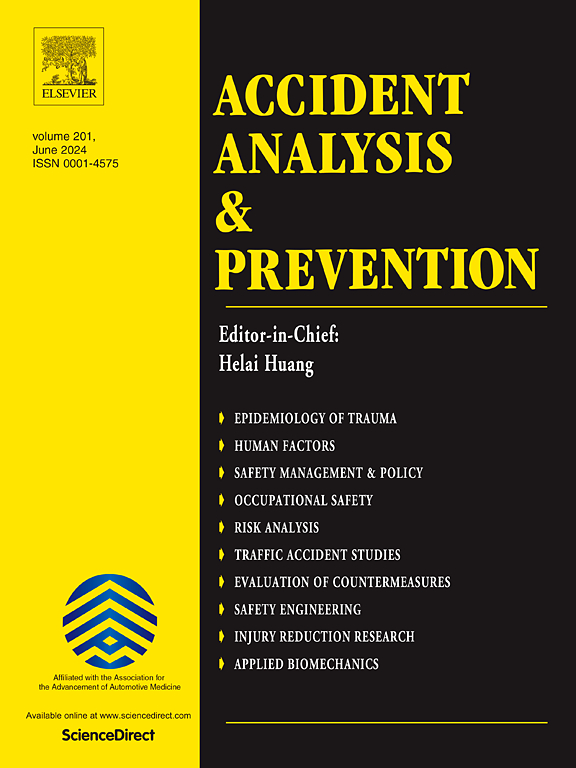交换配置安全比较工具
IF 6.2
1区 工程技术
Q1 ERGONOMICS
引用次数: 0
摘要
州际系统是一个完全访问控制的地面运输网络,连接不同地理区域的人员和货物的运动。维护和加强这一制度符合国家利益。服务交汇处是连接州和地方道路到州际系统的关键设施。当需要插入新的交换或修改现有交换时,请求将在交换论证报告(IJR)中提出。虽然每年都会提交许多IJRs,但建议的交换类型是有限的。根据交通分析结果,通常可以很好地描述立交对交通运行的改善。然而,由于缺乏安全建模工具,所提出的立交的安全性能往往没有得到很好的证实。历史数据表明,像交汇处这样的高流量设施随着时间的推移表现出稳定的交通崩溃模式,这意味着它们应该是可预测的。虽然很多因素都知道会导致交通事故,但安全界还没有完全掌握如何正确量化这些因素。将交换分解为简单的组件并将组件的年度崩溃预测相加通常不会产生与现场数据匹配的结果。联邦公路管理局(FHWA)开发了立交安全分析工具(ISAT),并支持其增强版本ISATe的开发。这两种工具都将交换分解为简单的组件以供分析。FHWA最近完成了一项研究,将服务立交作为一个整体,并使用规划阶段通常可用的输入数据来预测计划的服务立交的安全性能。它包括8种立交配置的安全预测,占FHWA审查的IJRs中考虑的所有立交的78%。本文介绍了该工具的功能,并解释了如何使用该工具。该工具为IJR审查人员提供了一种一致的方法,用于评估拟议的服务交换项目的安全性能。本文章由计算机程序翻译,如有差异,请以英文原文为准。
Interchange configurations safety comparison tool
The Interstate System is a fully access controlled surface transportation network connecting diverse geographical areas for the movement of people and goods. It is of national interest to preserve and enhance this system. Service interchanges are critical facilities linking State and Local roads to the Interstate System. When the need arises to insert a new interchange or modify an existing interchange, the request is presented in the Interchange Justification Report (IJR). Although many IJRs are submitted annually, the types of interchanges proposed are limited. Improvements in traffic operation due to proposed interchanges are usually well-described based on traffic analysis results. However, the safety performance of proposed interchanges is often not well substantiated due to a lack of safety modeling tools. Historic data indicates that high-traffic facilities like interchanges exhibit stable traffic crash patterns over time, meaning they should be predictable. Although many factors are known to induce traffic crashes, the safety community hasn’t fully grasped how to properly quantify those factors. Decomposing an interchange into simple components and adding up the components’ annual crash predictions generally doesn’t yield results that match field data. The Federal Highway Administration (FHWA) developed the Interchange Safety Analysis Tool (ISAT) and supported the development of its enhanced version, ISATe. Both of these tools decompose interchanges into simple components for analysis. The FHWA recently completed a study treating the service interchange as a whole and using input data typically available in the planning phase to predict the safety performance of planned service interchanges. It includes the safety predictions of eight interchange configurations representing 78 percent of all interchanges considered in IJRs reviewed by FHWA. This paper presents the functionalities of this tool and explains how the tool may be used. This tool gives the IJR reviewers a consistent methodology for assessing the safety performance of proposed service interchange projects.
求助全文
通过发布文献求助,成功后即可免费获取论文全文。
去求助
来源期刊

Accident; analysis and prevention
Multiple-
CiteScore
11.90
自引率
16.90%
发文量
264
审稿时长
48 days
期刊介绍:
Accident Analysis & Prevention provides wide coverage of the general areas relating to accidental injury and damage, including the pre-injury and immediate post-injury phases. Published papers deal with medical, legal, economic, educational, behavioral, theoretical or empirical aspects of transportation accidents, as well as with accidents at other sites. Selected topics within the scope of the Journal may include: studies of human, environmental and vehicular factors influencing the occurrence, type and severity of accidents and injury; the design, implementation and evaluation of countermeasures; biomechanics of impact and human tolerance limits to injury; modelling and statistical analysis of accident data; policy, planning and decision-making in safety.
 求助内容:
求助内容: 应助结果提醒方式:
应助结果提醒方式:


